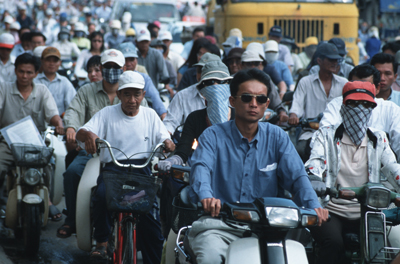Improving Urban Transportation in Ho Chi Minh City, Vietnam

Summary
Like other cities in rapidly industrializing Vietnam, fast-growing Ho Chi Minh City must invest in urban transportation, including new and better roads, a metro network, and a modern bus rapid transit (BRT) system. Lacking the full knowledge and skills needed to plan, build, and maintain such a transport network, Vietnam sought the help of the World Bank. The Bank responded with a South-South Facility grant to connect Vietnamese municipal and national government planners with Colombia and Brazil to learn from mature BRT systems, and with China and Indonesia to study newer BRTs implemented in similar, densely populated cities. Multi-department teams from Ho Chi Minh City and Da Nang, as well as representatives from several national ministries, visited the providing countries to learn best practices in urban planning, land use, and public-private partnerships, as well as financing and implementing BRT systems.
“[Visiting the bus rapid transit] systems provided a better understanding of the impacts, potential applications in Ho Chi Minh City, lessons learned on technical and design approaches, and the importance of integrated land use to optimize transit investments,” said Andre Bald, Senior Infrastructure Specialist at the World Bank in Vietnam. “Seeing the staffing and resource requirements to build and operate the BRT and mass transit systems was an eye-opener for the participants.”
The Vietnamese delegates learned how to plan, design, and implement BRT systems, mitigate environmental and social impacts, and use limited land more efficiently. The officials also became aware of different public-private partnership arrangements and ways to monitor and improve the quality of service. Additionally, the study tours demonstrated the importance of developing robust institutions to sustain urban transportation systems. The exchange exposed Vietnamese officials to different successful strategies, which will allow them to adapt relevant lessons to Ho Chi Minh City and other urban centers in Vietnam. Immediately after the study tour, the city identified a major transit corridor within which to develop its first BRT.
“[Bus rapid transit] is feasible to implement in Ho Chi Minh City and is needed to enhance the metro,” said Phuong Tran, Director of the Department of Transportation in Ho Chi Minh City. “This can and should be done.”
Beneficiaries / Participants
Vietnam is rapidly urbanizing. Ho Chi Minh City, responsible for almost 20 percent of Vietnam’s GDP, will nearly double its population to about 13.5 million by 2020.1 As in many Asian “mega cities,” Ho Chi Minh City’s poor transportation infrastructure causes traffic, pollution, accidents, and slows economic growth. Leaders have made plans to improve roads and build a six-line metro network in Ho Chi Minh City, but city officials also want to implement a bus rapid transit (BRT) system, a cost-effective complement to the metro system. Vietnam’s government sought the help of other middle-income developing countries that had implemented BRTs.
Rio de Janeiro and Curitiba in Brazil and Bogotá in Colombia have mature and very successful BRT systems, built with sound urban, transit-oriented planning. Hong Kong and Guangzhou, China, as well as Jakarta in Indonesia, operate BRTs in densely populated areas similar to Ho Chi Minh City. Using a South-South Facility grant, the World Bank organized a knowledge exchange for multi-department teams from Ho Chi Minh City and Da Nang, as well as representatives from several national ministries, to learn from the experiences of the six cities. The aim of the exchange was for the Vietnamese officials and technical staff to acquire skills to bridge immediate practical operational knowledge gaps in urban transport and environmental management.
Moving forward
Future investments and demands for increased urban mobility will radically change the role of the Ho Chi Minh City Department of Transportation (DoT) within the next five years. It will move from an organization that primarily builds roads and manages a fragmented bus system to one that operates a sophisticated multi-modal network. Because these are new areas for the DoT, it needs to increase knowledge and technical capacity to improve investment in urban transportation, especially BRT systems. The exchange was a significant part of the process to help Vietnam develop institutional arrangements and skills for planning and operations, modernizing the existing bus network, and focusing on integrated land use and transport planning. The knowledge gained during this exchange will also inform decision-making and improve coordination between donors and the private sector, as well as enhance public communications and consultation.
The ministry representatives also understood that the lessons learned could inform urban development in other major Vietnamese cities besides Ho Chi Minh City.

 China
China Colombia
Colombia Denmark
Denmark India
India Indonesia
Indonesia Mexico
Mexico Russian Federation
Russian Federation Spain
Spain United Kingdom
United Kingdom